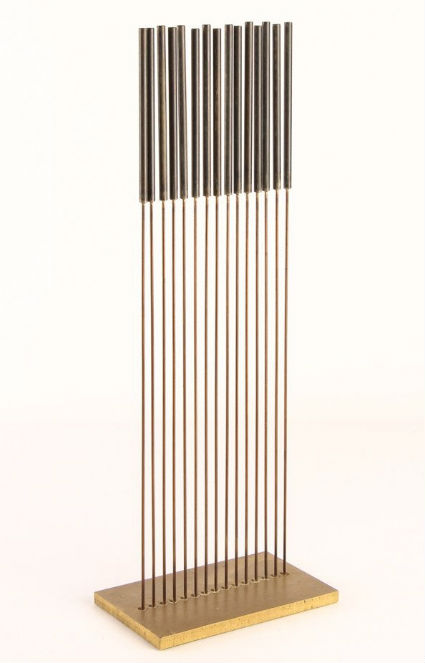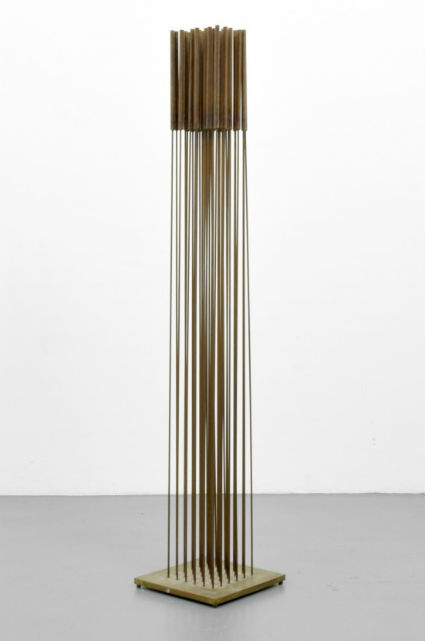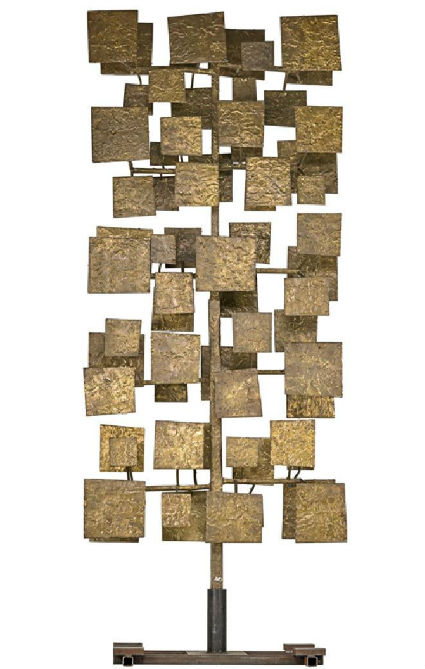
NEW YORK – It’s no secret that artists often borrow elements from other artists and incorporate them into their work. But occasionally an artist comes along who’s a true original – creating artwork that no one has created before or since. Harry Bertoia (1915-1978) was such an artist. Born in San Lorenzo, Italy, Bertoia moved to Detroit, Michigan, with his older brother at age 15 and enrolled in Cass Technical High School, where he started as a painting student but quickly fell in love with the design and making of handmade jewelry. It was just the first of several skills he would master.
In 1937, at age 22, he received a scholarship to study at the nearby Cranbrook Academy of Art. There, he encountered several giants in the design world, to include Walter Gropius, Ray and Charles Eames, Edmund N. Bacon and Hans and Florence Knoll. While World War II was still raging, the newly married Bertoia moved to California, to work for the Eames at the Molded Plywood Division of the Evans Product Co., designing furniture (artistic skill #2).
In 1946 Bertoia left the company and earned a living selling jewelry and monotypes (artistic skill #3). Monotypes are prized by collectors because of their unique textural qualities. They are made by drawing on glass or a plate of smooth metal or stone with a greasy substance such as printer’s ink or oil paint. Then the drawing is pressed by hand onto a sheet of absorbent paper or is printed on an etching press.

In 1950 a huge opportunity came his way when he was invited by Florence Knoll (his classmate at Cranbrook) to come to work for her and her husband Hans in Pennsylvania. He accepted, and designed five wire pieces that became known as the Bertoia Collection for Knoll. One of the designs – his diamond chair – is perhaps his most famous design effort. It was an elegant, fluid, sculptural form object made entirely from polished steel wires – a welded lattice work of steel – that took on a basket shape, with cushions resting upon it. It was an instant commercial success.
By the mid-1950s, Bertoia was doing so well from the sale of his chairs with Knoll that he could devote all of his energies to sculpture (artistic skill #4). He went on to produce over 50 commissioned public sculptures. Many of them are still on view today. In the 1960s, Bertoia began to experiment with something totally unique: sounding sculptures, made out of tall vertical rods on flat bases, designed to produce various sounds, like chimes and gongs.

Bertoia renovated an old barn into a makeshift concert hall and put in about 100 of his favorite “Sonambient” sculptures. He played the pieces in a number of concerts and went on to produce 11 record albums, all of them titled Sonambient. It was the music made by his art, manipulated by his hands along with the elements of nature. Years after his death, his daughter came across a large collection of near-mint original albums, on Bertoia’s property in Pennsylvania. These were sold as collector’s items. In 2015, the Sonambient recordings were re-issued as a boxed set, along with a booklet telling of their history, plus previously unseen photos.
Wade Terwilliger, the president and marketing director of Palm Beach Modern Auctions in West Palm Beach, Fla., said he actively encourages previewers to interact with a Bertoia sculpture. “The Sonambient sculptures invite you to run your hand over them, to stay and listen through to their last reverberation,” he said. “Reactions to the delicate strands of the Willow we had a few years ago were much the same: touch and hearing are as much a part of the sculpture’s appeal as its visual appearance. These were done in the 1960s and ’70s … and that mixed sensory experience is something that feels very current in a time when so much art being created right now is multimedia in nature.”

David Rago of Rago Arts & Auction in Lambertville, New Jersey, expressed the opinion that Bertoia doesn’t yet get the recognition he deserves. “But his work is accessible, relatively inexpensive and functional in its way,” he remarked. “I think Bertoia is something of an open secret, greatly admired by collectors of mid-century design but not as much by art collectors in general.”
Richard Wright, David Rago’s partner at the firm, agreed that Bertoia is an under-recognized artist. “While widely collected and in many museum collections,” Wright commented, “his artistic historical contributions have not been properly realized. Harry was a modest man and didn’t advocate for himself. He didn’t work with any of the major dealers in the day, often selling through Knoll or directly to friends. He even famously gave away many of his works as well. Finally, he designed one line of furniture but it was hugely successful and is still in production today. The commercial success of his furniture undercuts the perception of him as a pure artist.”

Wright said that Bertoia created several distinct series of sculptures, from the organic Bush Forms to architectural Multi-Panel constructions. “The Sonambient – or Sounding – works are arguably his most important series,” he said, “combining minimalism with an auditory and participatory experience, since the viewer was free to listen to and touch the works. He also produced the most work in this series.”
As for market demand for Bertoia sculptures, Rago said prices “seem a little off, down by maybe 15 percent. This is probably attributed to interested parties already having most of what they want. Still, there is a limited amount of the work available, and I see it having an enduring appeal. I would expect prices to somewhat stabilize and slowly rise in the next few years.”

Terwilliger disagreed, saying the market for Harry Bertoia’s work is at a stable place right now. “Overall, they are desirable, with large Sonambient (sounding) sculptures being a reliable seller,” he said. “The monumental dandelions, bushes and other flora are also among perennial favorites and command high prices. If estimated reasonably, they sell. I believe this confidence can be attributed in part to relatively clear authentication standards, and perhaps in part to the spread of information via the Internet, expanding his market outside of his regional area of eastern Pennsylvania.”
The Knoll historian Brian Lutz once said, “Bertoia’s paintings were better than his sculptures. And his sculptures were better than his furniture. And his furniture was absolutely brilliant.” Indeed, his iconic wire furniture collection, introduced in 1952, is recognized worldwide as one of the great achievements of 20th century furniture design, led of course by the diamond chair. It was only in 2005 that Bertoia’s asymmetrical chaise longue was introduced at the Milan Furniture Fair. It sold out immediately.


